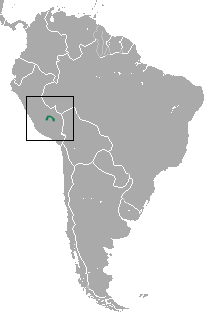
Opossums are members of the marsupial order Didelphimorphia endemic to the Americas. The largest order of marsupials in the Western Hemisphere, it comprises 126 species in 18 genera. Opossums originated in South America and entered North America in the Great American Interchange following the connection of North and South America.

Alston's mouse opossum, also known as Alston's opossum, is a medium-sized pouchless marsupial of the family Didelphidae. It is arboreal and nocturnal, inhabiting forests from Belize to northern Colombia. The main components of its diet are insects and fruits, but it may also eat small rodents, lizards, and bird eggs. It was formerly assigned to the genus Micoureus, which was made a subgenus of Marmosa in 2009.
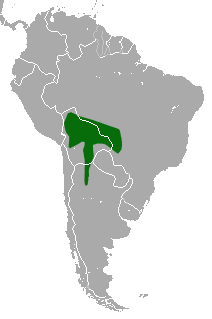
The white-bellied woolly mouse opossum is a small pouchless marsupial of the family Didelphidae. It was formerly assigned to the genus Micoureus, which was made a subgenus of Marmosa in 2009. The specific epithet was given in honour of Constance Sladen, wife of the naturalist Percy Sladen. She funded the 1902 expedition which collected the type specimen.

The bare-tailed woolly mouse opossum or short-furred woolly mouse opossum is a South American marsupial of the family Didelphidae. Its range includes Brazil, Colombia, Ecuador, Peru, and Bolivia. It is found in tropical rainforest in the westernmost portion of the Amazon Basin and the eastern foothills of the Andes, at elevations up to 1634 m. It was formerly assigned to the genus Micoureus, which was made a subgenus of Marmosa in 2009.

Linnaeus's mouse opossum, also known as the common or murine mouse opossum, is a South American marsupial of the family Didelphidae.

The red mouse opossum is a South American marsupial of the family Didelphidae. Its range includes eastern Ecuador and Peru.

The bushy-tailed opossum is an opossum from South America. It was first described by English zoologist Oldfield Thomas in 1912. It is a medium-sized opossum characterized by a large, oval, dark ears, fawn to cinnamon coat with a buff to gray underside, grayish limbs, and a furry tail. Little is known of the behavior of the bushy-tailed opossum; less than 25 specimens are known. It appears to be arboreal (tree-living), nocturnal and solitary. The diet probably comprises insects, eggs and plant material. This opossum has been captured from heavy, humid, tropical forests; it has been reported from Bolivia, Brazil, Colombia, Ecuador and Peru. The IUCN classifies it as least concern.

The gray four-eyed opossum is an opossum species from Central and South America, ranging from southern Mexico to Peru, Bolivia and southwestern Brazil, at altitudes from sea level to 1600 m, but generally below 1,000 metres (3,300 ft). Its habitats include primary, secondary and disturbed forest. It is one of many opossum species in the order Didelphimorphia and the family Didelphidae.

The black-shouldered opossum, also known as the white-eared opossum, is an opossum known from western Brazil and southeastern Peru. It was first described by Colin Campbell Sanborn, curator of Field Museum of Natural History, in 1951. The black-shouldered opossum is characterized by a gray coat, gray underbelly, and broad black stripes that extend from the forefeet, meet on the shoulders, run along the midline of the back and then split into parallel stripes that run down the hind feet. Little is known of the behavior of the black-shouldered opossum. It is nocturnal and arboreal. It is known to feed on fruits and rodents. The opossum inhabits humid forests. The IUCN classifies it as least concern.
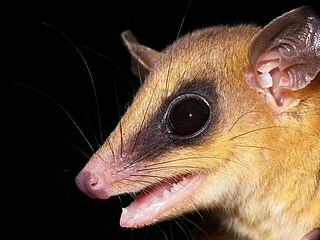
The 27 species in the genus Marmosa are relatively small Neotropical members of the family Didelphidae. This genus is one of three that are known as mouse opossums. The others are Thylamys and Tlacuatzin, the grayish mouse opossum. Members of the genus Marmosops used to be called "slender mouse opossums", but are now just called "slender opossums". The thirteen members of the Marmosa subgenus Micoureus, known as woolly mouse opossums, were formerly considered to be a separate genus, but were moved into Marmosa in 2009. Based on a comparison of sequences of one mitochondrial and three nuclear genes, three new subgenera, Eomarmosa, Exulomarmosa and Stegomarmosa, were recognized by Voss et al. in 2014. Eomarmosa and Exulomarmosa, as well as Marmosa and Micoureus, are thought to be sister taxa, while Stegomarmosa is viewed as sister to Marmosa plus Micoureus. Exulomarmosa is a mostly trans-Andean clade.

The agile gracile opossum, is an opossum species from South America. It is found in Argentina, Bolivia, Brazil, Colombia, Peru, Paraguay, and Uruguay.

The grayish or gray mouse opossum is a diminutive species of opossum in the family Didelphidae, endemic to Mexico. It is the sole species of its monotypic genus, Tlacuatzin.

The Mexican mouse opossum is a species of North American opossum in the family Didelphidae.

Robinson's mouse opossum is a species of opossum in the family Didelphidae. It is found in Belize, Colombia, Ecuador, Grenada, Honduras, Panama, Peru, Trinidad and Tobago, and Venezuela.
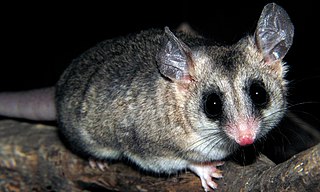
The elegant fat-tailed mouse opossum, also known as the Chilean mouse opossum, is an opossum from central Chile. The type species of Thylamys, it was first described by English naturalist George Robert Waterhouse in 1839. This medium-sized opossum is characterized by black rings around the eyes, white limbs, gray to light brown coat, lighter flanks and underbelly and a thick 12.7–14.6 centimetres (5.0–5.7 in) long tail covered with hairs. It is crepuscular and lives in nests in tree hollows or under rocks and roots. This opossum feeds mainly on arthropods and larvae apart from fruits. Litter size is typically between 11 and 13. The elegant fat-tailed opossum can occur in a variety of habitats – from cloud forests to chaparrals. The IUCN classifies the opossum as least concern.

The white-bellied fat-tailed mouse opossum is a species of opossum in the family Didelphidae. It is found in Argentina, Bolivia, Chile and Peru.
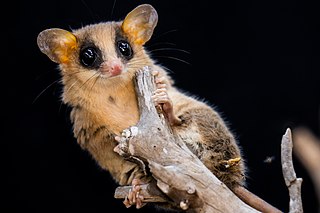
Gracilinanus is a genus of opossum in the family Didelphidae. It was separated from the genus Marmosa in 1989, and has since had the genera Cryptonanus, Chacodelphys, and Hyladelphys removed from it.

The Quechuan mouse opossum is a South American opossum species of the family Didelphidae. It is known from two areas of montane forest on the eastern slopes of the Andes in Peru, at altitudes from 300 to 2700 m. The type locality in the Valle de Occobamba is in the southern area, in Cuzco Region, while the northern area is in the vicinity of Moyobamba in San Martín Region. The true range may be more extensive and possibly extends into Bolivia. The northern area has suffered from habitat destruction, but the southern area is not seriously degraded.
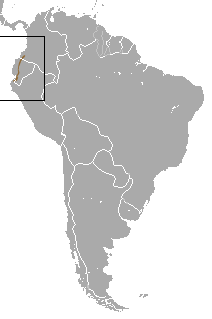
The little woolly mouse opossum is a nocturnal, arboreal and mainly solitary South American marsupial of the family Didelphidae. It is native to the western slopes of the Andes in Colombia, Ecuador and Peru, where it lives at altitudes from sea level to 1500 m. It primarily inhabits lowland rainforest and montane cloud forest, although it has been reported from dry forest in the southern end of its range. It was formerly assigned to the genus Micoureus, which was made a subgenus of Marmosa in 2009. Its conservation status is Vulnerable, due to habitat fragmentation and continuing loss of habitat via urbanization and conversion to agriculture.
The Isthmian mouse opossum is a species of opossum in the family Didelphidae found in Colombia, Ecuador, and Panama.
